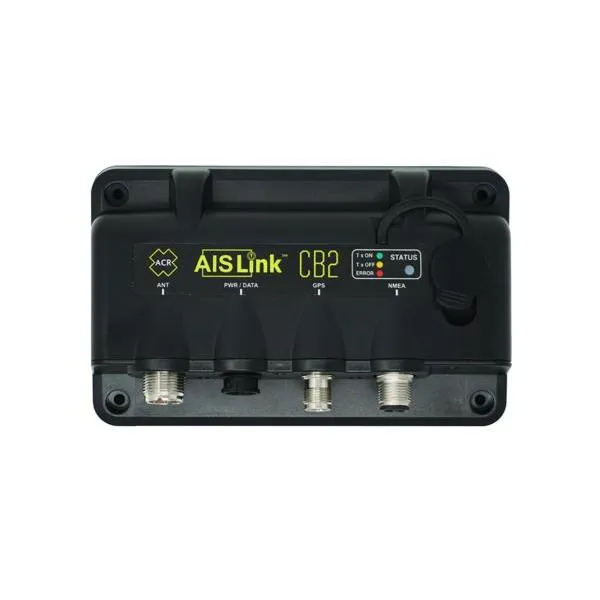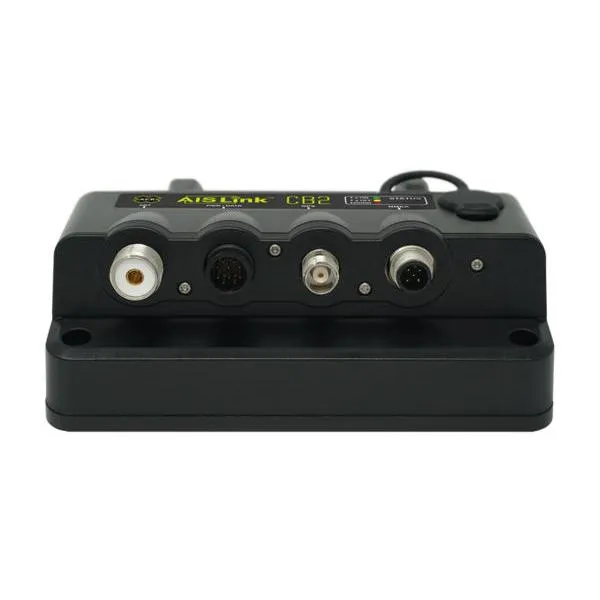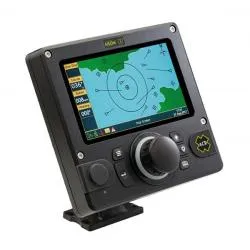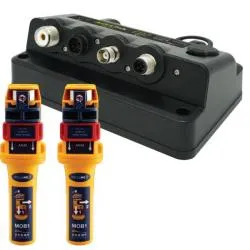Description
The AISLink CB2 AIS Transponder is a fully compliant, waterproof Class B+ transceiver designed to help avoid collisions. Using advanced SOTDMA (Self Organized Time Division Multiple Access) technologies from Class A transponders, the AISLink CB2 features inherent advantages, including a faster reporting rate and higher output power concerning all Class B products that use the older CSTDMA (Carrier Sense Time Division Multiple Access) technologies on the market.
The CB2 needs to be configured by the user to enter the vessel's MMSI number and other details. This can be carried out by a mobile app or a web-based program:
- For the Mobile iOS version, search the App Store for ACR AIS Config
- For the Mobile Android version, search the Play store for ACR AIS Config
Using technology from Class A AIS, the CB2 has a faster reporting rate with reserved time slots for transmissions to ensure your broadcast does not get blocked in high traffic areas. The AISLink CB2 will transmit every 5 seconds while older Class B AIS units can only transmit once every 30 seconds. The CB2 also transmits at 5 watts of power, versus older Class B AIS that only transmit at 2 watts, broadcasting to a larger area for improved visibility. Utilizing 99 acquisition channels and 33 tracking channels, the internal multi-GPS receiver continuously transmits your vessel information including position, speed, course and heading, ensuring an indication of the most accurate global positioning at all times. In addition to transmission of dynamic vessel information, the AISLink CB2 also continuously transmits static information including vessel name, call sign, vessel type, vessel dimensions, and MMSI number. Programming static information into the AISLink CB2 proves effortless as the user has the ability to simply upload this information via Wi-Fi using ACR’s free mobile app. For increased flexibility for the maximum number of users, the app is conveniently available from either the App Store (Apple) or the Google Play Store (Android). Upon completion of the quick and easy installation process, the AISLink CB2 receives and interprets messages from other AIS equipped vessels within range and then seamlessly communicates this information to other navigation devices on your vessel such as chart plotters, laptops or mobiles using the CB2’s NMEA 0183, NMEA 2000®, USB or WiFi outputs.A primary benefit that users can rely on is the transmission priority provided by the AISLink CB2 due to the use of the SOTDMA access scheme versus CSTDMA. Use of SOTDMA guarantees the same AIS transmission priority as a class A transponder, ensures a faster reporting rate with transmissions every 5 seconds instead of every 30 seconds, and also ensures a higher output power of 5 Watts instead of 2 Watts. These features not only allow the CB2 to convey a more “real-time” picture of your vessel’s position, but also enables your transmissions to reach further.Additional benefits include a multi-color LED indicator light communicating the ongoing operational status of the unit. Given that the CB2 also comes complete with an external GPS antenna, users have the ability to be transmitting AIS messages and enjoying the many benefits of the AISLink CB2 within minutes of install. The AISLink CB2 provides a significant advantage in navigational safety, giving you the peace of mind that your vessel will be seen day or night on even the busiest waterways, regardless of what the weather may be.As a leader in life-saving marine products for both professional and recreational use, ACR provides unparalleled safety and peace of mind with the AISLink CB2 AIS Transceiver.Features and Benefits:- 5 Watts of Power - More than double that of older Class B units
- 12 Times the Transmissions Per Minute – 12 Times Versus 2 transmissions with CSTDMA
- Guaranteed Time Slot Reservations
- Increased visibility to other vessels
- FREE user-friendly mobile app for set up and controls
- Wi-Fi, USB, NMEA 0183 and NMEA 2000 connectivity
- Simple to install and use
- Superior internal 99-channel GPS receiver
- External GPS antenna (Included)
- Multi-color LED indicator light
- Receives and interprets messages from other AIS equipped vessels
- Durable waterproof design
- Low energy consumption
Installed Unit Boxed Unit 1 Unzip the zip file attached to this email to a USB stick*
(Do not drag the entire folder)Unzip the zip file attached to this email to a USB stick*
(Do not drag the entire folder)2 Ensure the systemb.bin file is in the top level directory of your USB stick and not in a folder Ensure the systemb.bin file is in the top level directory of your USB stick and not in a folder 3 Power down the CB2 Remove the CB2 unit, USB On-the Go cable and power cable from the box 4 Connect the USB stick to the CB2 using the USB on-the-go cable supplied Connect the USB stick to the CB2 using the USB on-the-go cable supplied 5 Power up the CB2 Connect the power cable to a 12V dc Power Supply or battery 6 The LED will flash amber then green 6 times then turn to flashing red The LED will flash amber then green 6 times then turn to continuous red 7 After a short wait (while the GPS obtains a fix) the LED will turn green Disconnect the power supply 8 Press and hold the LED button for 10 seconds (until it flashes Amber) to eject the USB stick Remove the USB cable and stick 9 It is now safe to remove the USB stick Return the CB2, USB On-the-Go cable and power cable to the box 10 The CB2 will return to normal operation
Name:CB2 Class B AIS TransceiverProduct Description:Class B AIS TransceiverApplication:Coastal Cruising, Sailing, Offshore Recreational, ChartersWaterproof:IPx7 (1 meter for 30 minutes)Weight:0.36kg / 0.8lbsWarranty:2 Years (plus 1 on registration)Dimensions:101 x 162 x 58mmTemperature Range: Operational: -5°F to +131°F (-15°C to +55°C)AIS Transmitter Frequency range:156.025 – 162.025 MHzReceiver Sensitivity:107dBm for 20% packet error rateAIS Receiver Frequency range:156.025 – 162.025MHzTransmit Power (EIRP):AIS – 5 WattPower Supply:10.8 – 31.2 VdcGPS receiver:High Sensitivity, 99 acquisition/33 trackingSerial Ports:NMEA 0183 [2 Rx, 2 Tx]NMEA2000® [DeviceNet]1 x USB1 x WiFi IEC802.11 bgnFAQsWhat information is transmitted?Position reports (MMSI, Lat, Long, COG, SOG) for Class B (SOTDMA)- Every 3mins. when SOG < 2 knots
- Every 30s when SOG >= 2 knots < 14 knots
- Every 15s when SOG >= 14 knots < 23 knots
- Every 5s when SOG > 23 knots
- Every 6mins.
- Typical transmit range for Class B is 10nm
- Typical receive range for Class A targets is 20nm
- Receive range can exceed 100nm in the right conditions
This can be carried out by a mobile App or a web based program:- For the Mobile Android version search the Playstore for ACR AIS Config
- For the Mobile iOS vesion search the App Store for ACR AIS Config
- For the Web version click here: CB2 New Configuration Program

from this merchant give
them a 4 or 5-Star rating.
















































































